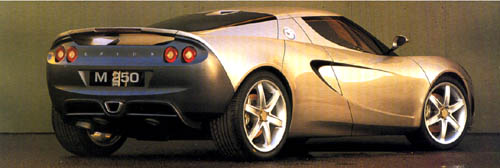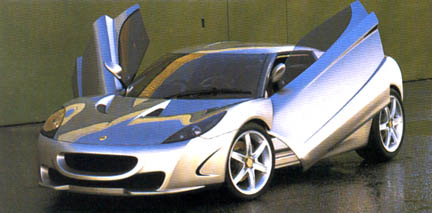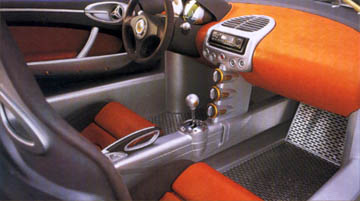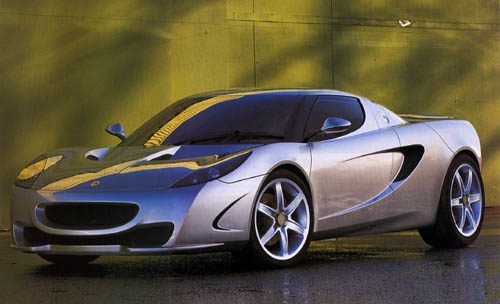…And This One Is Just Right
The striking Lotus M250 will finally fill the gap between the bare-bones Elise and the high-priced Esprit.
By Ian Kuah
The weather in Norfolk is always extreme and on this cold and windy winter’s day, the rapidly changing light provides an opportunity to see the Lotus M250 in a whole variety of conditions. Though based on a modified version of the Elise’s extruded and glued aluminum platform, the new car will actually fill the gaping chasm between Lotus’ entry model and the stalwart EspritV8, whose days are undoubtedly numbered.
Any way you look at it, this new addition to the Lotus clan is drop dead gorgeous, not a single line in its sleek and compact body is superfluous or out of place. It looked good at the Frankfurt Motor Show back in September, but now, this more fully realized example, which was shown at the London Motor Show in October, looks even better. With the soft winter sun dancing on its unique blend of classical form and late 20 th Century detailing, the M250 looks lithe and light, yet taut and solid at the same time. Cars like the Porsche 911 GT2 and Lamborghini Diablo grab your attention with their in-your-face presence. They look dramatic and brutish, boldly alluding to motorsport connections and big horsepower numbers. Though the M250 has an underlying toughness, its sleek and dynamic shape uses a different visual dialogue of form and stance that says "speed" without giving away how fast it is or how much power is concealed under its smooth, elegant exterior.
Lotus design chief Russell Carr calls it an athletic form with attitude." "We wanted to keep the elliptical front intake which is 1960s Lotus," he explains. "Some of the details are off our more recent models. The top-exiting radiator is Elise and is unique to us among mainstream manufacturers. The mean-looking angled headlights are 340R and are part of the interplay of hard and soft lines." The mix works brilliantly to produce a car that looks more expensive than its projected 05,000 price tag.
In typical Lotus fashion, the rear wheels are larger than the fronts, in both width and diameter. Fairly large 225/40ZRI8 front tires and very meaty 285/35ZRI9 rear Pirelli P-Zero Asimmetrico rubber on 8x17 and lOxl9 six-spoke alloys fill the fenders and help to give the car its crouched, purposeful stance. In the best Lotus tradition, the M250 will bear a proper name beginning with "E" by the time it reaches production-Emas is one name being bandied about at the moment. For now, however, it's being called by its internal code name of M250, referring to the horsepower generated by the proposed mid-mounted, transverse, 3-liter V6.

Lotus candidly admitted to us that they have not actually settled on the source of that engine. Whichever motor is adopted, it will be reworked to provide the exact performance characteristics that Lotus desires. Lotus admits that it is currently testing power units from GM and Renault, both companies with which it has long-standing ties. GM was, of course, once Lotus' foster parent, while Renault has been the source of Esprit gearboxes for many years. Bets are on a Renault unit, specifically the V6 installed in the mid-engined Renault Sport Clio. Despite brick-wall aerodynamics, this engine's 250 hp and 221 lb/ft of torque are sufficient enough to allow the 2646-pound Clio to claw its way to 60 mph in under six seconds and on to 160 mph flat out. That augurs well for the sleek Lotus, whose target weight is 2200 pounds, including ABS, air-conditioning, six-speaker stereo with CD changer and even satellite navigation. Russell Carr told us that their performance targets are a sub five-second 0-60 mph time, 0- 100 mph in under I I seconds and an electronically limited 155mph top speed. Although this engine could work in the M250 almost straight out of the box, the five-speed Renault gearbox would have to be modified or substituted as the Lotus plan is for a six-speed manual or even a sequential box.
"We could have started with a clean sheet of paper," Carr explains, "but we consider that there is a lot right with the Elise, and so we decided to capitalize on its inherent strengths." On the other hand, the Elise is a 130 mph car and the M250 will be a 160 mph car, so major alterations had to be made. These include a longer wheelbase (99.1-inch) for more interior room and enhanced high-speed stability. The seats are slightly higher and broader. In fact, the sense of space in this two-seater is remarkable, and all but the very tall should be happy. Aerodynamic stability is a critical issue at 160 mph and a lot of wind-tunnel work will be done to ensure that the car is totally stable at such speeds. "The faster it goes, the more downforce it will generate," says CarT of the underbody diffuser and exterior shape. The M250's handling will be more benign if no less engaging than the Elise's. "We aim to make it the best handling Lotus ever and it will also sound great and feel very special to drive," he adds.
I have always said that you really get to know a car when you wash or polish it. In the course of our photo shoot, the winter skies opened up several times, causing us to wheel the car quickly back into the R&D workshop. Helping the Lotus crew lather it off gave me a very good opportunity to examine and appreciate every nook and cranny of this incredibly convincing full-scale clay model. In fact, I found it hard to believe that the car was made from clay. With perfectly finished and painted bodywork, it easily passed off for the real thing, as did the strikingly authentic interior. Of course, the fact that the bodywork was firmly attached to a real working modified Elise aluminum chassis helped to underscore the illusion. The bodywork of the production car will use either Lotus RRIM composites or aluminum.
One of the ergonomic weaknesses of the Elise is that its wide sills call for feats of contortion to achieve ingress and egress, particularly with the top on. Not so for the M250, which is meant to be a practical everyday coupe. Reach for the door handle concealed under the top of the sculpted side intake and the door lifts upwards and forwards on a hydraulically assisted strut to clear the way for easy entry. The seats are quite far forward for an optimum center of gravity, so these wide opening doors are quite necessary. Lotus has cleverly re-engineered the chassis so that more of the side impact protection is incorporated into the butterfly- winged doors. Thus, the sill attached to the floorpan is lower making the leap from tarmac to seat one of natural movement rather than faith.

The M250's cabin is a visual treat. The Elise was always meant to be spartan, but the M250 has an eloquence of simple design vocabulary that turns basic elements like the door pulls into an art form. This is a car that will be aiming at the same target audience as the Porsche Boxster S. It may not be as plush as the Porsche, but if plush means plastic, then Lotus renounces that approach with a refreshingly different use of aluminum for both its cabin architecture and controls. In this prototype, soft orange/brown leather covers the race-style seats, dashboard and door inserts, while bare aluminum is used to articulate functional components. The big speedo and tach are neither futuristic nor retro. Instead, they open yet another new visual design chapter, re-inventing the classical white calibrations on a black background. Particularly striking are the suspended center console, which contains the gear linkage, and the unique guillotine- style handbrake lever. The short gearlever itself extends from a Ferrari-esque chromed gate and is topped by a round ball knob.

The three vent and heating control knobs on the center console look like the knobs on the front panel of some exotic and expensive high-end audio amplifier. They are a feast for both the eyes and the finger tips. Above this, on the dashboard proper, is the housing for the radio and four buttons for the front and rear foglights, rear window defroster and hazard lights. The big red engine start button takes centre stage and should make firing up the motor an occasion. Pursuing the turned aluminum theme to the hilt, the designers have incorporated the vents and the door opening pulls into aluminum ovals in the door casings-neat touch. The small "eyeball" vents even have miniature Lotus crests in their centers, accounting for two of the nine Lotus logos in the M250's interior. Another pair can be found in the aluminum race harness support at the backs of the seats, four on the seat back adjusters and the largest one in the center of the handsome leather-bound three-spoke steering wheel. Incidentally, there is room behind the seats for storing small suitcases or soft bags, and Lotus may even produce bespoke luggage for the car. Certainly two golf bags will fit.
Even at this early stage of the game, the M250 has created a huge amount of customer and media interest. The good news is that Lotus now designs cars for world-well, some of the world-distribution from day one. That means the final version will not differ much in appearance from this prototype. Officially, the party line is that the model is still being considered for production, but both the Board of Lotus and their customers know that the company desperately needs a practical, mid-priced model
to augment the hugely successful but impractical Elise and the aging, low-volume Esprit. The production target is around 3000 M250s a year, the same number as the Elise. For this relatively small sports car maker that is currently building a new R&D center and hiring talented new staff like there is no tomorrow, the issue is not "if' but "when." If the project does get the green light, the car could be in European dealerships by the first half of 2001. And get this American enthusiasts, the M250 has been designed to allow for US production.
SPORTS CAR INTERNATIONAL Apr/May 2ooo

